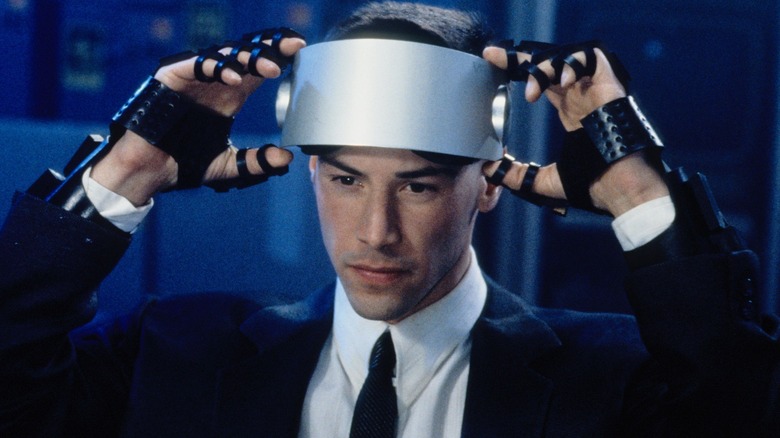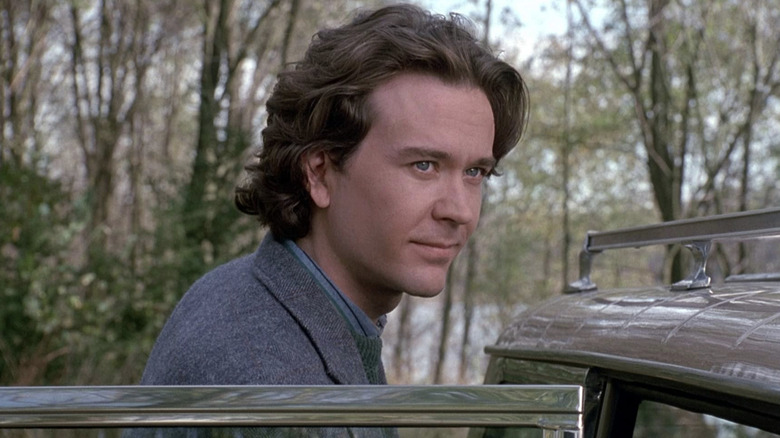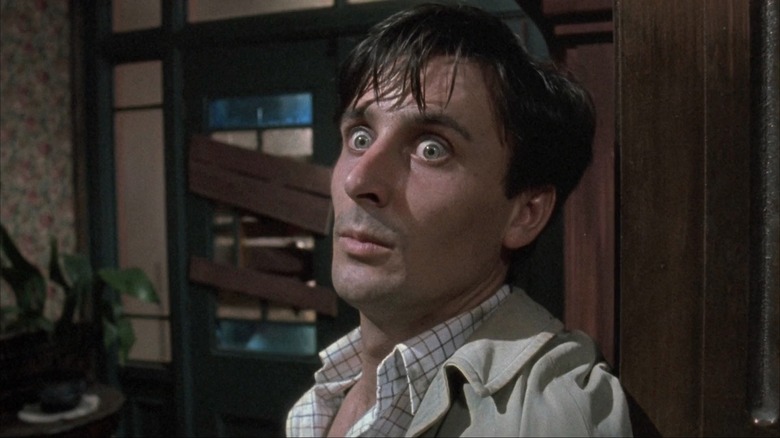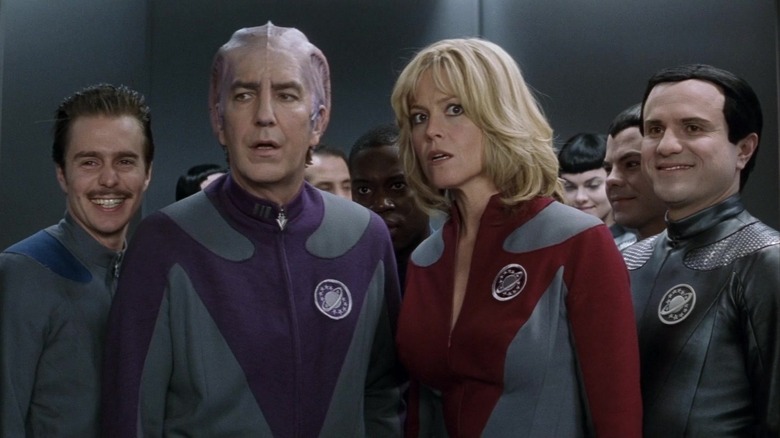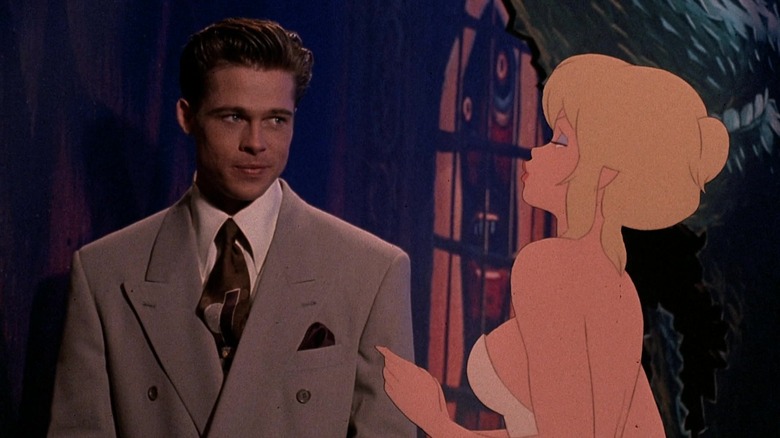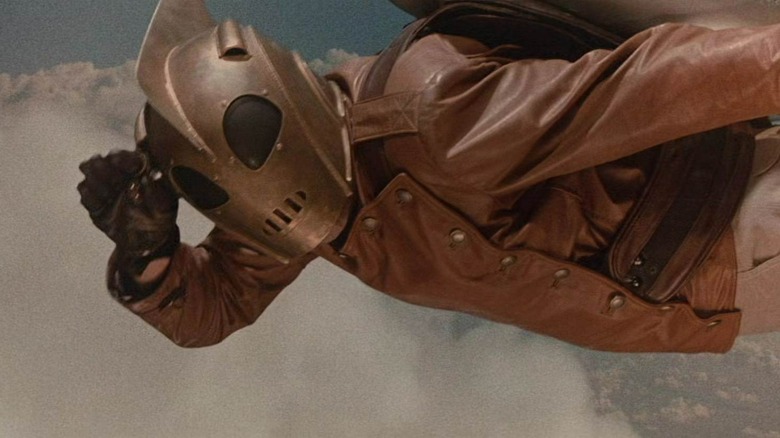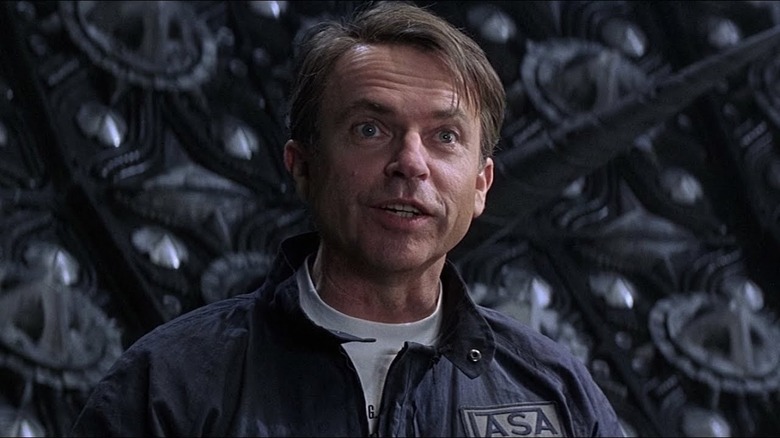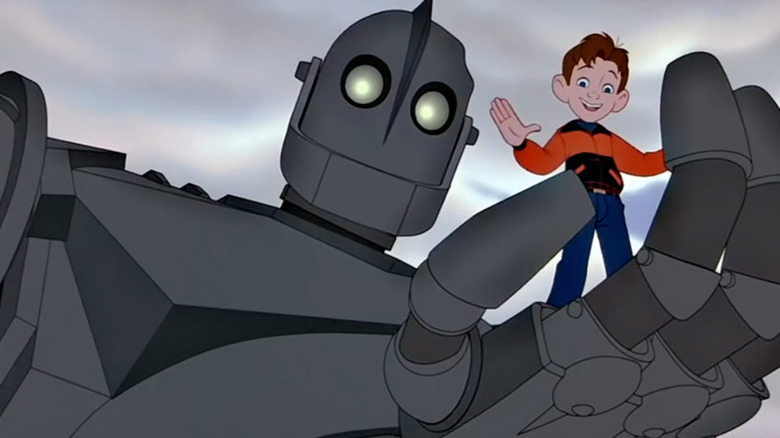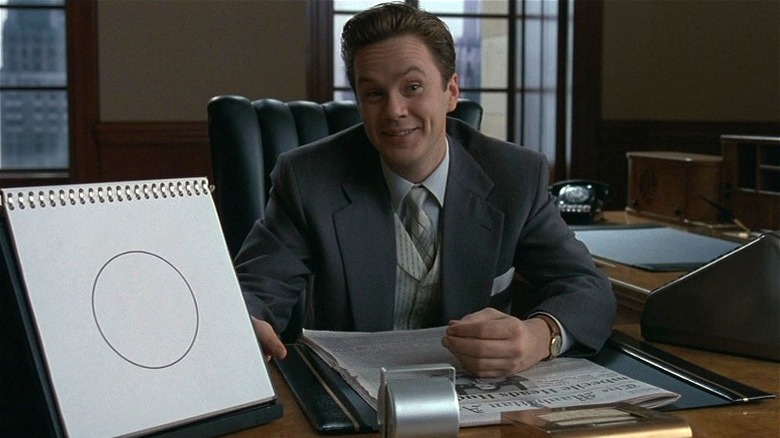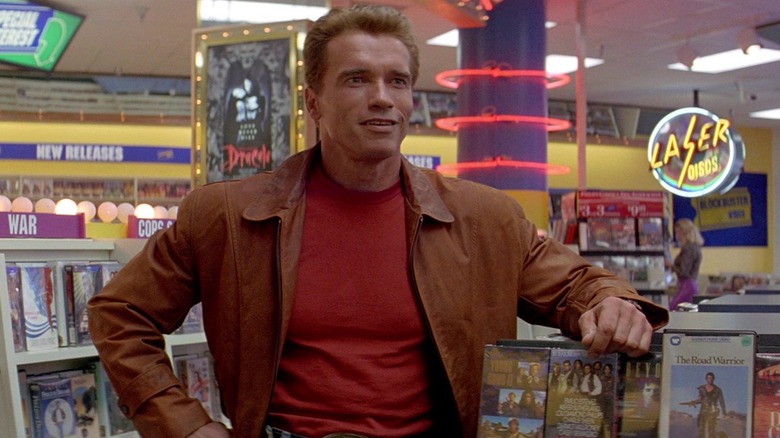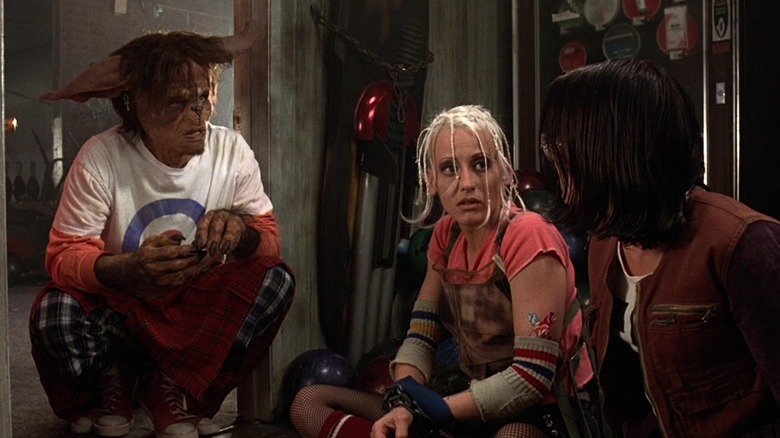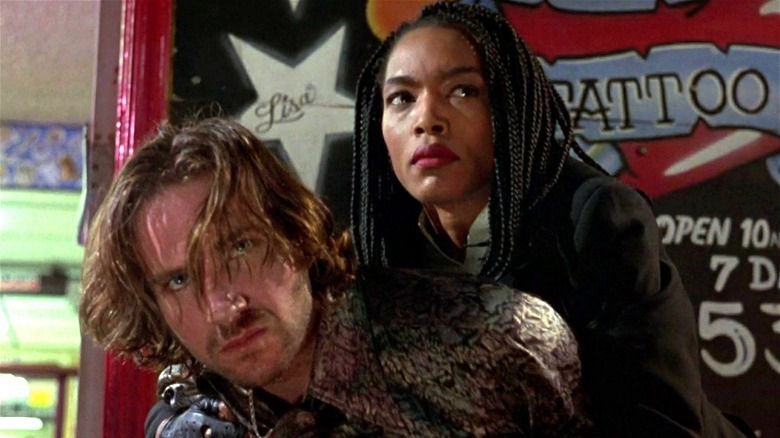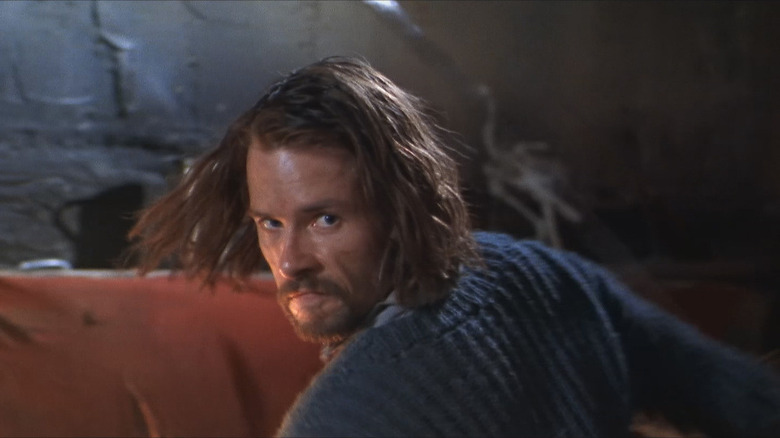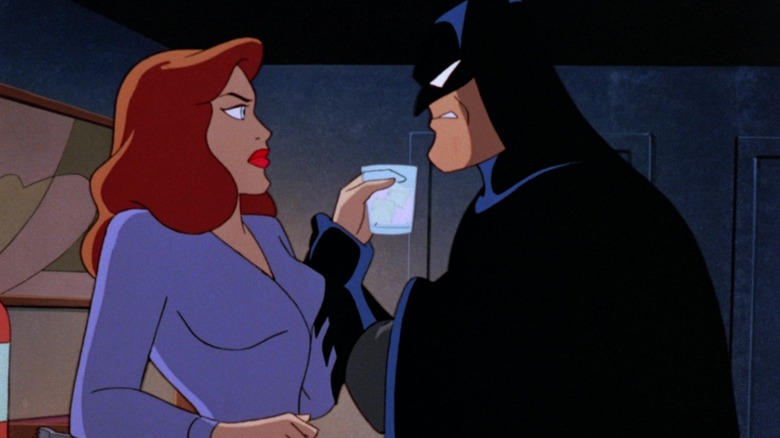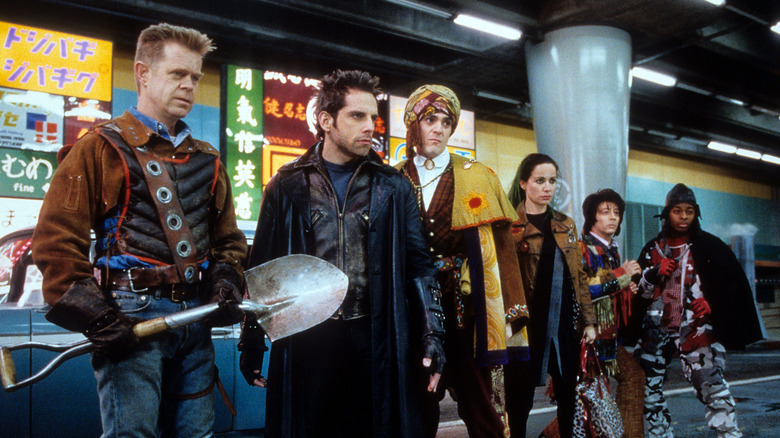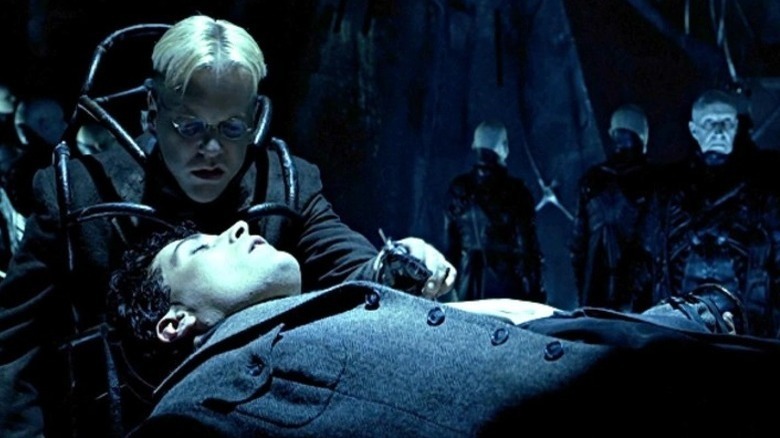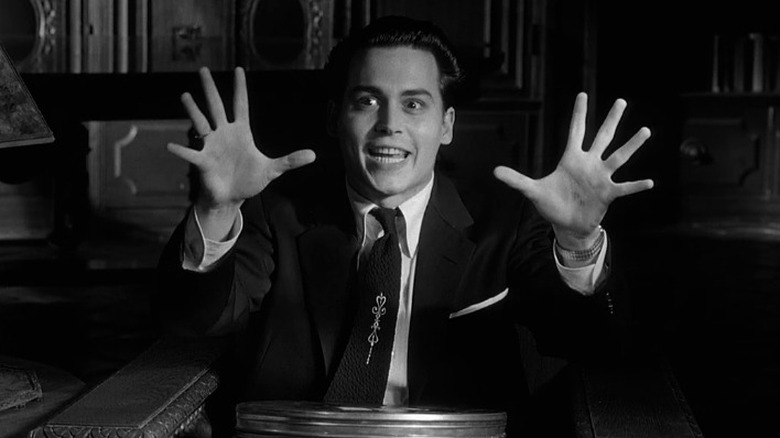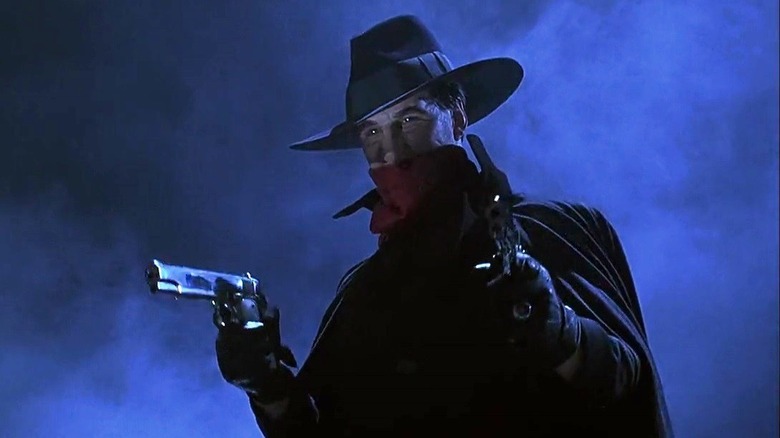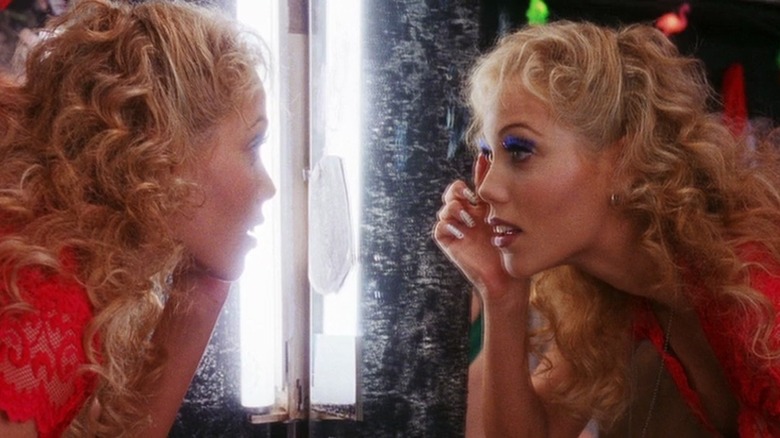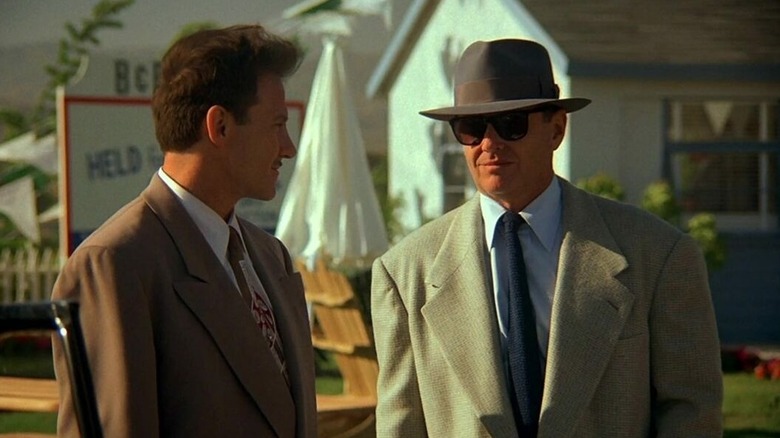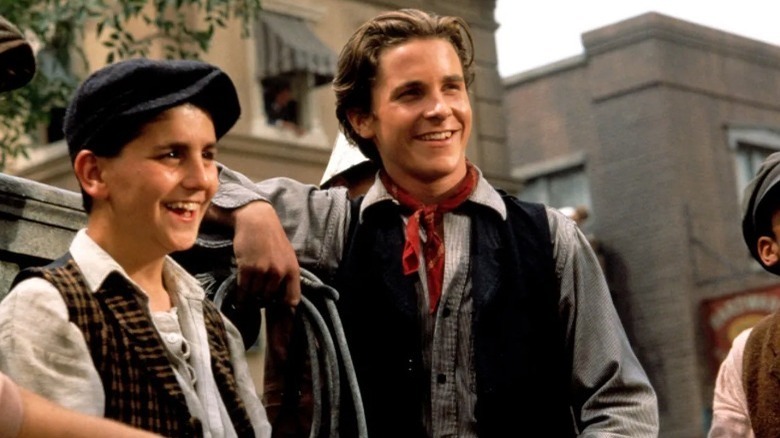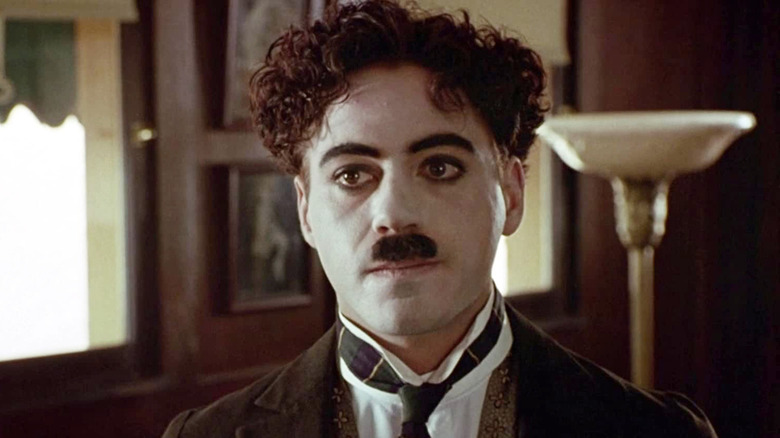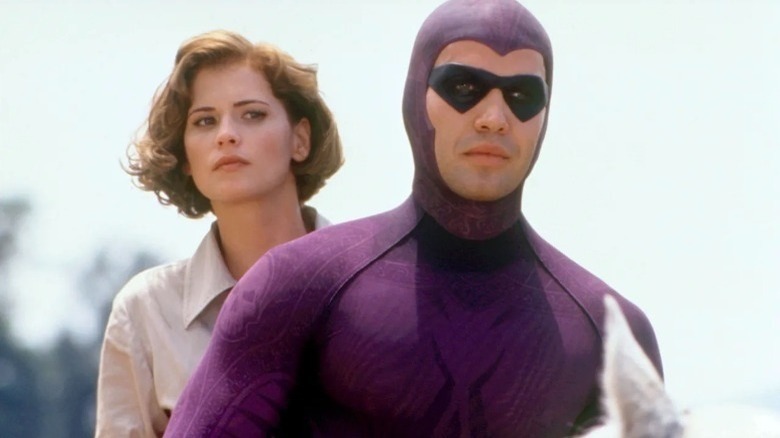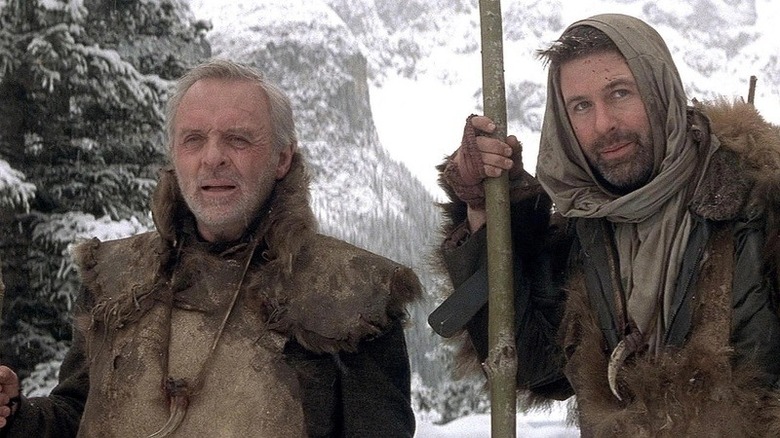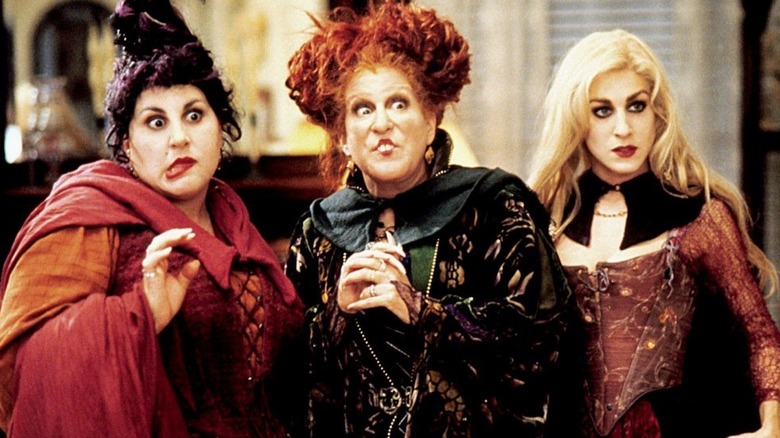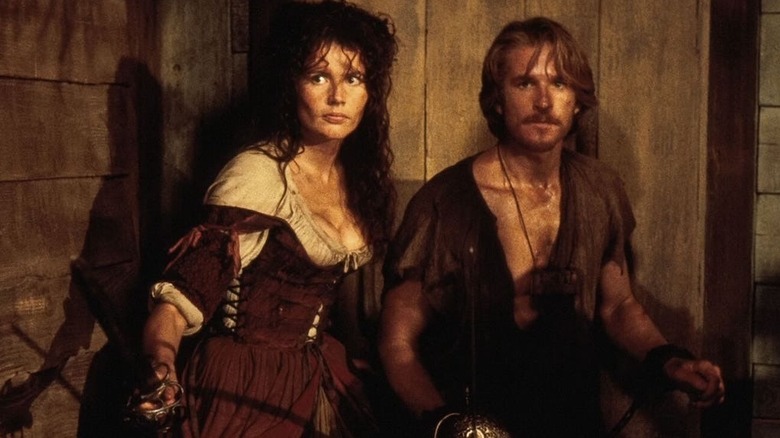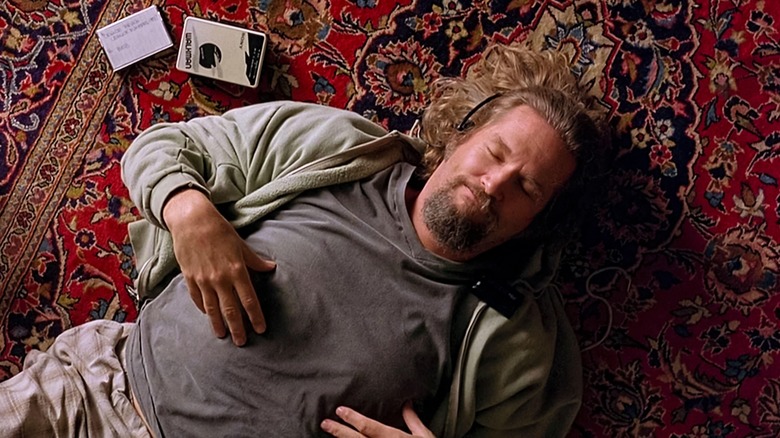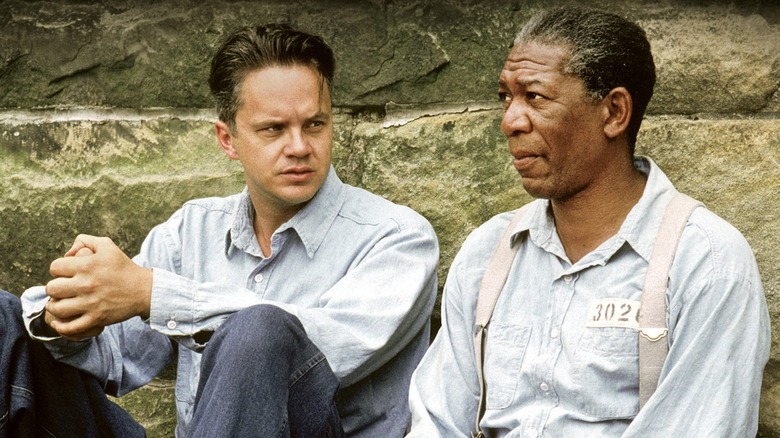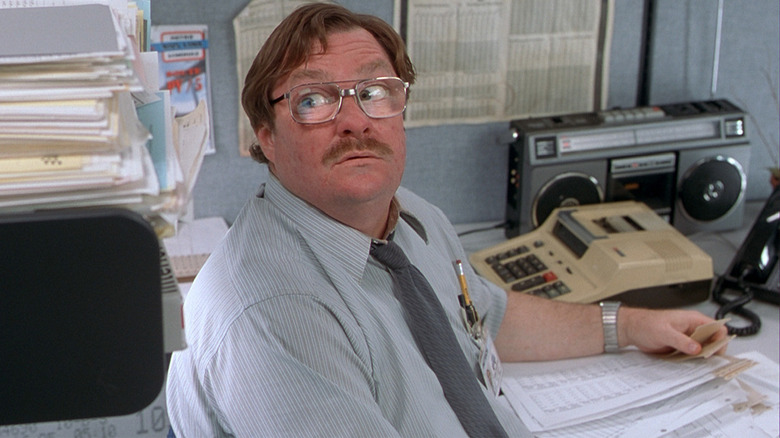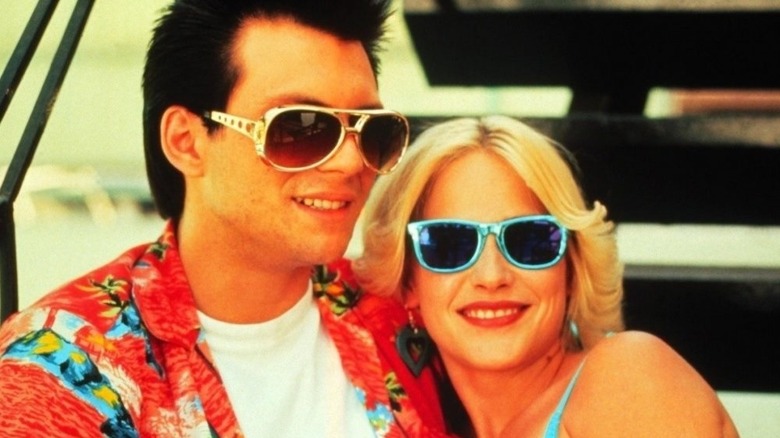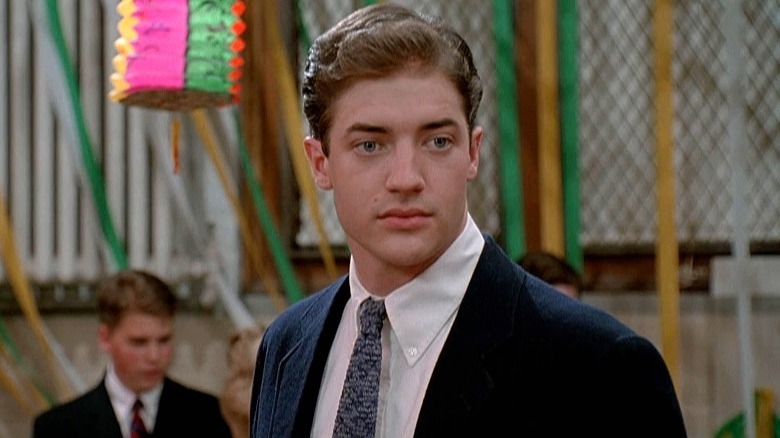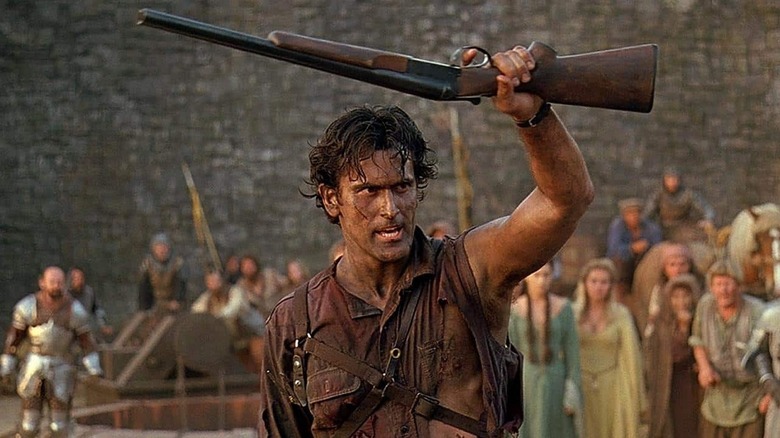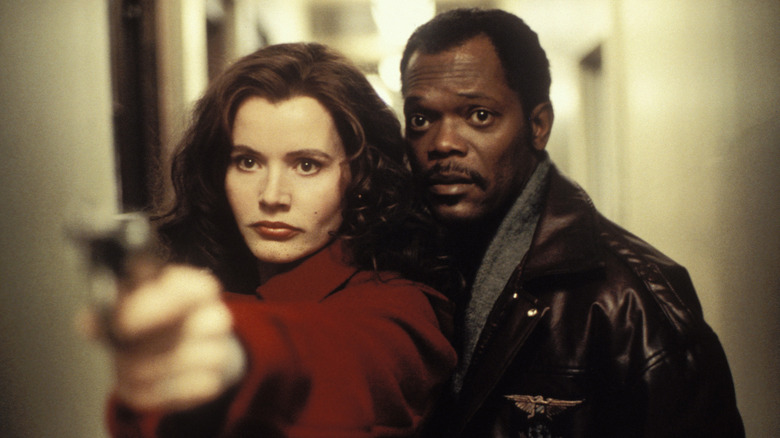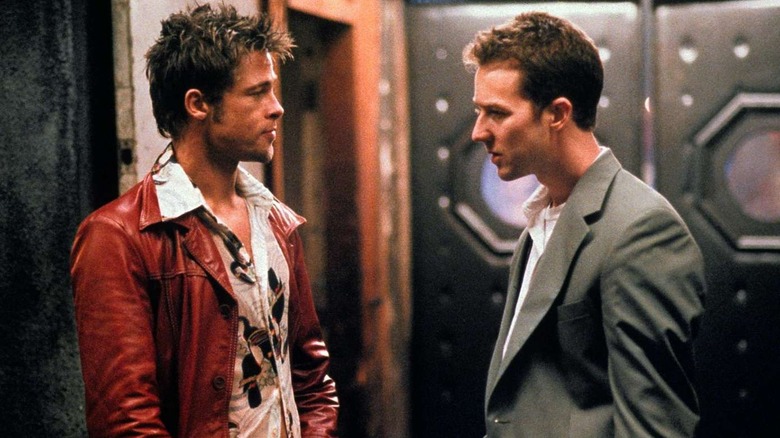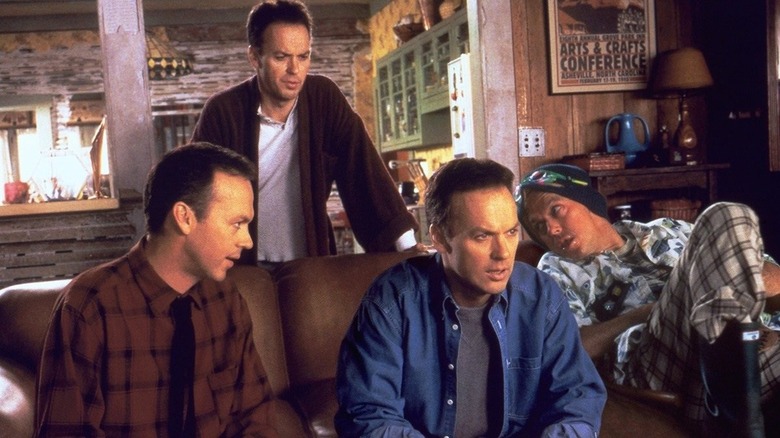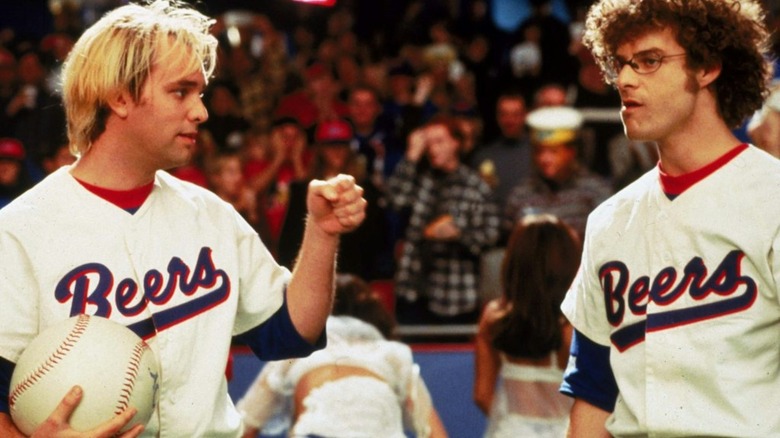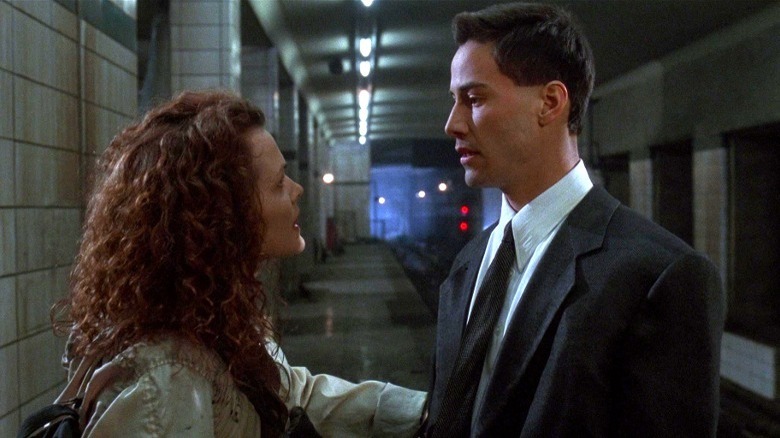Box Office Bombs From The '90s That Are Actually Worth Watching
Movies, like all art, shouldn't be judged solely by their financial worth. After all, not all great art is appreciated in its time. With today's audiences paying close attention to weekend box office returns and rankings, it can be hard for even the most inventive movies to overcome the reputation of a big loss at the box office.
Box office bombs are declared quickly, and post-mortem editorials on what went wrong are sometimes penned before their opening weekend has even concluded. Sadly, money talks, but some art is in it for the long haul, so that doesn't mean you should always listen.
When you're watching a movie decades later, box office receipts become completely irrelevant. After all, if it was good then, it still has the goods today, even if audiences at the time couldn't see that. Below are some movies from the 1990s that bombed at the box office when they dropped in cineplexes, but are well worth your time.
The Dark Half (1993)
"The Dark Half" is based on the novel of the same name by the spooky king of horror prose, Stephen King. Definitely one of his stranger concepts, it's the story of a writer who has abandoned his nom de plume, only to find his phony persona has come to life — with murder on its mind. While the novel has a concept perfect for the written word, the movie has one excellent attribute that makes it a standout: The late cinematic king of horror, director George A. Romero.
"The Dark Half" delivers some gruesome images up there with Romero's best. One scene in particular features a brain tumor "reacting" to its removal — a scene that will make you anxious the next time you get a headache. Unfortunately, the movie failed to click with audiences; it made just over $9.5 million from a reported budget of $15 million. That's a real shame, because the movie's definitely worth a watch, especially with an adept Timothy Hutton (best known later for the TV series "Leverage") in a double role playing both the writer and his evil pseudonym counterpart.
Dead Alive (1992)
Peter Jackson's "Dead Alive" (also called "Braindead") was one of the most surprising horror films of the '90s. Made on a shoestring budget of only $3 million by Jackson (who would of course get used to directing on a much larger budget with his "The Lord of the Rings" and "Hobbit" trilogies), "Dead Alive" is a gory, inventive romp about a young man fighting off a horde of zombies (and dealing with some nasty mother issues, too). Although its low budget should have made it an easy success, the film only made around $240,000, and it would be unjustly ignored by American audiences until Jackson's later success prompted a re-evaluation.
While it didn't quite connect with American audiences, the film had a profound influence on another young horror buff across the pond in Edgar Wright, who would pay homage to the film in his own movie "Shaun of the Dead." Even setting its influence on other movies aside, "Dead Alive" is an electrifying and darkly funny horror flick with some of the best practical effects of all time — including a truly innovative use of a lawnmower. You might think you've seen bloody horror movies, but you've almost certainly never seen anything quite like "Dead Alive."
Galaxy Quest (1999)
DreamWorks didn't know what it had in "Galaxy Quest." Upon its release in 1999, the sci-fi comedy about the cast of a "Star Trek"-type TV series getting whisked away on a real space adventure opened at an embarrassing #7 at the U.S. box office. As DreamWorks co-founder Jeffrey Katzenberg would later admit, the studio bungled the promotion of the quirky, whip-smart comedy as a kid-targeted adventure, and by and large failed to sell the movie to mass audiences — there are plenty of things that only adults will notice in "Galaxy Quest."
Nevertheless, the film picked up momentum over the course of its theatrical run, eventually recouping twice its production budget over the course of five months. Maybe it's an exaggeration to call it a "box office bomb" considering its long term success, but it's clear that it could have performed so much better if given the proper support. Thankfully, "Galaxy Quest" is now a highly-regarded film in the sci-fi canon, boasting great performances from Sigourney Weaver, Tim Allen, and the late Alan Rickman.
In addition to being a charming work in its own right, "Galaxy Quest" also has a special place in the hearts of "Star Trek" fans, who have cheekily adopted it into their own (uneven) film canon. It's a film, in part, about fandom itself, and its devotees honored it with the retrospective documentary "Never Surrender: A Galaxy Quest Documentary" for its 20th anniversary in 2019.
Cool World (1992)
Ralph Bakshi, the man that made the infamous X-rated animated film "Fritz The Cat," combined intimacy and cartoons one more time with "Cool World." In it, a cartoonist (Gabriel Byrne) has to resist the sexual advances of his own creation, a "doodle" named Holli Would (voiced by Kim Basinger). Meanwhile, a detective (Brad Pitt) works to prevent her from breaking down the boundaries of reality. It can be a strange movie, with a juxtaposition of live-action and animation that looks like an adult parody of "Who Framed Roger Rabbit," but it's a fascinating experiment.
Audiences weren't exactly drawn to the film, and it ended up only recouping around half of its $30 million budget, which isn't exactly surprising. While it likely won't turn up on anyone's "Best of the '90s" list anytime soon, the film is so singular in its conception that it's worth seeing, at least once. "The plot is too sketchy to provide much of a framework, and the only logic here is the logic of fevered daydreams," said the Orlando Sentinel in one of the film's most positive reviews. "Yet, in spurts, the movie's enjoyable."
The Rocketeer (1991)
Captain America is box office gold today, but in the early '90s, a superhero period piece about a handsome, patriotic hero in WWII could barely cover its own budget. "The Rocketeer" follows mechanic Cliff (Billy Campbell) as he becomes a hero by donning a stylish jacket and rocket pack to uncover a hidden enemy plot in Hollywood. The film is entertaining and well paced with stylish design (Art Deco never really goes out of style), yet it only made around $46 million from a $35 million budget, which came as a blow for Disney during what was a tough year for Hollywood studios.
It's easy to see why director Joe Johnston got the chance to reinvent another superhero decades later with "Captain America: The First Avenger." He does some great work in "The Rocketeer," a criminally underrated film that just didn't really connect with audiences, probably because it wasn't fronted by a big-name star. Also, it was released too early to tap into the superhero zeitgeist and it struggled against films like "City Slickers" and "Robin Hood: Prince of Thieves," which hit cineplexes around the same time. "The Rocketeer" is absolutely worth revisiting today, especially for Timothy Dalton's performance as an over-the-top, Errol Flynn-esque actor.
Event Horizon (1997)
While "Alien" might be the most well-known horror movie that takes place in space, it's far from the only one. The slow-burning Paul W.S. Anderson flick "Event Horizon" taps into that uniquely human fear of space as an endless, empty void. The movie follows a crew investigating a distress signal coming from the titular spaceship, which had disappeared seven years prior. What follows is a kaleidoscope of horrifying images, spooky Latin phrases, and the creeping realization that flying millions of miles through space doesn't put you any further away from hell.
"Event Horizon" is arguably Anderson's best movie, combining the bloody genre thrills that pervade his other work with an able cast that is able to inject the necessary gravitas. Sam Neill in particular is absolutely terrifying as the member of the space crew most susceptible to the dark whispers of the otherworldly horror on the ship. If the "Alien" movies didn't completely turn you away from space travel, then "Event Horizon" certainly will. Watching it back, it's hard to fathom that it only made $26 million. With a budget of $60 million, that makes it one of the most notable flops of the day.
The Iron Giant (1999)
The late 1990s were a time of rapid change in the animation industry. The Disney Renaissance had revived mass interest in animated films, but Disney alone seemed capable of turning one into a massive hit. After the continued success of Pixar proved that computer-driven animation was here to stay, studios across Hollywood and beyond were scrambling for a direction. It was during this time that Warner Bros. recruited animator Brad Bird to overhaul their process with an ambitious new feature called "The Iron Giant."
"The Iron Giant" is a masterful film on both a technical and story level, showcasing the potential of blending traditional and digital animation in service of spinning a heartwarming sci-fi twist on a classic "boy and his dog" narrative. Accessible to kids but textured enough for adults, "The Iron Giant" is just about everything you could want from an all-ages animated adventure film. Sadly, by the time it was finished, Warner Bros. had already given up on its feature animation department.
The financial failure of their previous release, "Quest for Camelot," convinced them to get out of the business, so "The Iron Giant" was released with minimal promotion and recouped a mere $23 million from its $70 million budget. A twist ending was yet to come, however, as critical acclaim and frequent replays on Cartoon Network helped the film find a cult following. Today "The Iron Giant" is a recognizable pop culture touchstone and is widely considered one of the best animated movies of all time.
The Hudsucker Proxy (1994)
The Coen brothers have made a successful career for themselves with a slew of idiosyncratic scripts. While they've found plenty of success, and cult status, that doesn't mean they're immune to failure, even for one of their best movies. "The Hudsucker Proxy" is a biting satire of big business, a loving homage to classic feel-good movies like "Mr. Deeds Goes To Town" and "It's A Wonderful Life." The film follows Norville Barnes as he moves to New York from Indiana and accidentally becomes head of a massive company as the unknowing patsy for a complicated scheme to depress stock prices.
As with any Coen brothers movie, the film is packed to the brim with memorable dialogue and likable characters, but the look of "Hudsucker" was so striking that more than a few critics and audiences felt put off and confused. It ended up pulling in less than $3 million from a budget of $40 million, making it a notable failure. A more cohesive look at the Coen brothers' larger oeuvre would reveal the kinds of stories they were interested in telling, which makes "The Hudsucker Proxy" a much more fulfilling theatrical experience. If nothing else, there's never been a better explanation for why hula hoops exist.
Last Action Hero (1993)
"Last Action Hero" has the perfect recipe for a hit movie in the 2020s. Conceived as a pastiche of the witty action comedies of screenwriter Shane Black (it was later rewritten by Black himself), the film stars Arnold Schwarzenegger and is directed by John "Die Hard" McTiernan. For modern audiences who love nothing more than when movies shamelessly riff on other, more familiar movies, it'd likely have been both a critical darling and a box office hit today.
In 1993, "Last Action Hero" was seen as a career-threatening dud for all involved. It barely stood a chance to begin with, opening against the second weekend of "Jurassic Park." Critical reception didn't do it any favors, either. Variety dismissed it as "a joyless, soulless machine of a movie," and they weren't its only haters. The film seriously underperformed at the domestic box office and would be Schwarzenegger's only outright flop of the 1990s.
In hindsight, "Last Action Hero" is one of Arnie's better comedies. Part "Terminator 2" (Robert Patrick even has a cameo as the T-1000), part "Who Framed Roger Rabbit?", and part Robert Altman's "The Player," it's an absolute treat for fans of '80s and '90s Hollywood excess. It's certainly more watchable today than Schwarzenegger comedies like "Junior" and "Kindergarten Cop." It's joke-dense, action-packed, and littered with Easter eggs for the eagle-eyed cinephile. The fact that it only made $50 million from an $85 million budget is a crime.
Tank Girl (1995)
The original "Tank Girl" comics are an energetic, frenetic, counter-culture blast to the eyeballs with a unique art style by Jamie Hewlett, but it was the character of Tank Girl herself that endeared the comic to fans. She was rude, hyper-violent, and so utterly unconcerned with other people's opinions that she became a '90s embodiment of riot grrrl-adjacent punk. Depicting a comic with such a specific visual voice and main character might have been a tall order, but director Rachel Talalay's film adaptation of "Tank Girl" does about as good a job as it's possible to do with the backing of a major film studio.
To start with, Lori Petty is a picture-perfect Tank Girl, nailing the irreverence and punk attitude of the character. The movie is visually abrasive at times, but the dynamite soundtrack and charismatic lead make it worth a watch. Just be prepared for your senses to be assaulted. "The movie version of the graphic comic book is a classic case of kitchen-sink filmmaking, in which the principals have thrown everything into the stew, hoping enough will stick to the audience," Variety said in its review at the time. It's almost impossible to defend or recommend — you either "get" it or walk away shaking your head. Sadly, those who walked away shaking their heads after seeing the film in cinemas back in 1995 clearly told others not to watch it, because it only made $4 million from a budget of $25 million.
Strange Days (1995)
Today, filmmaker Kathryn Bigelow is best known as the first woman to win the Academy Award for best director, scooping the big prize for her brilliant film "The Hurt Locker." Prior to this, Bigelow's career was nearly tanked by the colossal box office failure of her 1995 cyberpunk noir "Strange Days." Written by Bigelow's ex-husband James Cameron and occasional Martin Scorsese collaborator Jay Cocks, "Strange Days" is a stylish, visceral thriller set in a near-future in which memories can be recorded, relived, and exchanged on the black market. When a memory dealer (Ralph Fiennes) happens across a recorded memory of a heinous crime, he teams up with a lovelorn badass (Angela Bassett) to solve a case that the police don't seem to care about.
"Strange Days" divided critics upon its release and was a commercial disaster, winning back just short of $8 million on a $42 million budget. In the decades since, however, "Strange Days" has been rediscovered and re-evaluated as a lost treasure of genre cinema and an example of some of Kathryn Bigelow's finest work as a director. With an unflinching eye and style to spare, "Strange Days" touches on themes of police brutality, sexual violence, and the voyeuristic spectacle of suffering, all of which are as relevant today as they were in 1995. It also features one of the great unsung heroines of science fiction in Angela Bassett's Lornette "Mace" Mason. Notoriously hard to find but occasionally reappearing on major streaming services, "Strange Days" is well worth hunting down.
Ravenous (1999)
"Ravenous" is a brilliant subversion of audience expectations, a horror movie that's as funny as it is scary. The film follows a mid-19th century war hero exiled in the Sierra Nevada. He's investigating stories of a Wendigo — a human given otherworldly strength after eating the flesh of another man. Guy Pearce shines as the ousted captain, struggling with survivor's guilt and the consequences of the actions which brought him into exile. The entire cast is able to tap into the film's tone, pushing for laughs in humorous scenes and giving weight to the dramatic ones.
Ultimately, the film's a biting (no pun intended) satire of American exceptionalism, capitalism, and Manifest Destiny. It's a rare film that's able to make such subject matter work within a horror movie structure — and doubly so within a film that's funny as well. Audiences likely missed out on this underrated picture due mostly to a trailer that misrepresented the tone of the movie, selling it as an awkward, comedic period piece. Don't be fooled, though, "Ravenous" has a lot of meat on its bones. Not that you'd think it from looking at its box office receipts — while it cost just $12 million to make, it only managed to make a little over $2 million.
Batman: Mask of the Phantasm (1993)
Even thirty years after its debut, "Batman: The Animated Series" remains the gold standard for American superhero cartoons, and perhaps the definitive screen adaptation of the character. The series was a critical and commercial success, leading Warner Bros. to order additional episodes, plus a feature film for home video release. When WB executives got a peek at the film that directors Eric Radomski and Bruce Timm were making, they excitedly upgraded the project from direct-to-video to theatrical release.
Rising to the challenge of producing a feature-quality animated movie, the creators delivered "Batman: Mask of the Phantasm," a deep, dramatic, suspenseful thriller that digs into the past and psyche of Bruce Wayne as well as (if not better than) any of its live-action contemporaries. It's a showcase for Kevin Conroy and Mark Hamill's beloved portrayals of Batman and the Joker, respectively, plus there's a terrific turn from Dana Delany as the fascinating love interest Andrea Beaumont.
However, despite suggesting a theatrical release for "Phantasm" in the first place, Warner Bros. barely promoted the film ahead of its debut in 1993; it grossed a mere $5.6 million at the U.S. box office. It wouldn't be until its release on VHS the following year that an audience beyond die-hard Batman fans would come to appreciate the film, largely due to a glowing review from tastemakers Gene Siskel and Roger Ebert. Decades later, "Mask of the Phantasm" is a cult classic among those who grew up watching "Batman: The Animated Series."
Mystery Men (1999)
Superhero movies might not have been all that popular in the '90s, but they were at least more popular than superhero parodies. With that in mind, "Mystery Men" never really had a chance. The film cost a whopping $68 million to make, but only managed to bring in $33 million worldwide. Still, people who slept on the film missed an endearing superhero story with one of the strangest casts ever assembled (Ben Stiller, William H. Macy, Tom Waits, Eddie Izzard, Paul Reubens, Hank Azaria — and a Michael Bay cameo, for Pete's sake). It's a quintessentially '90s movie, complete with a music video tie-in to Smash Mouth's "All Star."
With the current glut of superhero movies, it's a delight watching the misfits of "Mystery Men" fumble around with their mostly useless superpowers. In fact, the current climate in Hollywood means many of the jokes in the film have actually improved with age. After revisiting the film in 2012, Time Out heaped praise on director Kinka Usher, an unknown French helmer with a background in TV commercials. "Usher's amiable spoof of superhero movies takes a brave stab at rewriting the mythology from the inside out, with lots of witty, mildly subversive stuff." Unsurprisingly, Usher hasn't worked in Hollywood since, but is no doubt happy that more recent appraisals of his sole feature film have been on the kind side.
Dark City (1998)
As frustrating as it must be for any artist to be years ahead of their time, it must be agony to precede their moment by mere months. Such was the case for writer/director Alex Proyas, whose 1998 film "Dark City" is a rain-soaked, leather-clad sci-fi thriller about a man who learns his reality is not what it seems and that he and everyone he knows is being manipulated by an invisible malevolent force. If you think that sounds exactly like 1999's "The Matrix," you're not the only one — the people who saw "Dark City" in theaters also thought so, as did critic Roger Ebert.
"Dark City" was dropped into theaters during the dumping ground month of February in 1998, debuting at #4 at the domestic box office and sliding ever downward from there, barely winning back its $27 million budget. Just a year later, "The Matrix" would become a massive pop cultural phenomenon and Hollywood action cinema would never be the same. "Dark City" (which features the likes of Rufus Sewell, William Hurt, Kiefer Sutherland, Jennifer Connelly, and Richard O'Brien) would have to settle for cult classic status.
Perhaps in no universe does "Dark City" receive the same love and attention as the Wachowski masterpiece; after all, "The Matrix" is arguably the best sci-fi film of all time. Nonetheless, "Dark City" still deserves better than languishing in obscurity. Weird, moody, and distinctively '90s, it's like a missing tonal link between "The Matrix" and "Blade Runner," and is worth a watch for any science fiction devotee.
Ed Wood (1994)
In 1994, Tim Burton pivoted away from his usual flights of fancy toward a quirky, black-and-white biopic saluting filmmaker Edward D. Wood Jr., known for his low-budget science fiction, crime, and horror films. Starring Johnny Depp as the titular auteur of shlock, "Ed Wood" is a terrific showbiz comedy with tremendous heart. Wood's story (or, at least, this version of it) fits the Tim Burton mold perfectly, painting a portrait of a man whose quirks make him an outsider until he seizes the opportunity to share his uniqueness with the world. Unlike the talented Edward Scissorhands, however, what makes Edward Wood unique is a total blindness to how terrible his art really is.
"Ed Wood" is Tim Burton's most critically-celebrated film. However, for all its acclaim, it was a clunker at the box office, recouping only about a third of its $18 million production budget. It remains Burton's lowest-grossing film by far, and he has rarely strayed from his signature blood-and-pinstripes aesthetic since. One can only imagine what Burton's career path might have looked like if "Ed Wood" had been a success, or if he had at least received some personal validation on the awards circuit for his work on the film (while the director wasn't given a look, Martin Landau did scoop a best supporting actor Oscar for his turn as horror movie icon Bela Lugosi).
The Shadow (1994)
A debonair billionaire who spends his evenings fighting the forces of evil is often a recipe for a blockbuster. When that billionaire is Bruce Wayne and his alter ego is Batman, people usually come flocking, but when it's Lamont Cranston — aka The Shadow — on the big screen, it's a different story. Despite being a big inspiration for Batman, The Shadow has never come close to reaching the same heights as The Dark Knight.
Debuting in 1930, nearly a decade before Bob Kane with Bill Finger debuted Batman, The Shadow was a mainstay on radio and B-movie serials throughout the 30s and 40s. Yet it would be 64 years before he got the big budget tentpole treatment with 1994's "The Shadow." Starring Alec Baldwin as the eponymous avenger, "The Shadow" cost $40 million but only swooped up $31 million, less than Tim Burton's "Batman" made in one weekend in 1989. That's a shame, because it's not a bad film.
"The Shadow" deserved more than its eventual box office, and way better than its mediocre reviews. Anchored well by Baldwin and bolstered by an all-star supporting cast (including John Lone, Ian McKellen, and Peter Boyle), "The Shadow" is a fun, pulpy popcorn flick. It's also scored with grim grandeur by maestro Jerry Goldsmith. Why did "The Shadow" bear such bitter fruit at the box office? Only The Shadow knows.
Showgirls (1995)
In his prime, Dutch filmmaker Paul Verhoeven was such an effective satirist of American culture and cinema that American filmgoers (and even critics sometimes) had trouble knowing when he was joking. This happened most famously upon the release of his 1997 sci-fi epic "Starship Troopers," a broad, over-the-top send-up of pro-war propaganda that went over the heads of an audience to whom jingoistic violence was so ubiquitous that it became a vision worth embracing.
Such was also the case with Verhoeven's previous film, "Showgirls," a ridiculous, exploitative, NC-17-rated drama about a young woman trying to make it as an exotic dancer in Las Vegas. Broadly panned upon its release for its cranked-to-eleven acting and intimate scenes that overshoot "sexy" by miles, "Showgirls" was a commercial disaster, grossing about $20 million on a $45 million budget. In the years since, however, "Showgirls" has become an iconic film of the 1990s.
Some fans see it as a riotous parody and have mined it for inspiration in drag shows, stage reenactments, and other gleefully garish rituals. This legacy is explored in the loving 2019 documentary "You Don't Nomi." Still, others feel that there's nothing funny about "Showgirls" at all, and that its superficial hyperbole is the only way to truly capture the cruel, misogynist meat grinder of the entertainment industry. Either way, "Showgirls" has been rescued from the dustbin of infamy and frequently appears on cable, streaming services, and at art house theaters — typically around midnight.
The Two Jakes (1990)
Making a sequel to an iconic movie isn't usually a good idea. Well, unless you're Jack Nicholson, arguably the best actor of all time. Even if "The Two Jakes," his 1990 sequel to 1974's "Chinatown," doesn't come close to its predecessor, it's still pretty darn solid. Nicholson is back as private investigator J.J. "Jake" Gittes, who is hired by the other Jake in the title, Jake Berman (Harvey Keitel), for routine work. Too bad for Jake #1 that Jake #2 decides to murder his business partner, who is also his wife's lover, which sucks Gittes into a web of conspiracy.
The plot is a lot, especially when the movie contrives a connection to "Chinatown" (guess Gittes didn't take the advice to "Forget it, Jake, it's Chinatown"). You'll be forgiven for being a little confused at some points, but we don't watch retro detective stories for coherence, we watch them for the coolness, and this film is bursting with it. Sadly, after "The Two Jakes" tanked with only $10 million in box office receipts, the film was practically forgotten about, though many critics feel this is a shame. "'The Two Jakes' may not be a masterpiece, and it certainly never approaches the Greek-tragic grandeur of 'Chinatown,'" wrote the Los Angeles Times. "But it's also a richer, more resonant movie than its nonexistent reputation suggests."
Newsies (1992)
Disney is no stranger to live-action box office bombs, but before the likes of "The Lone Ranger" and "John Carter," one of the Mouse House's biggest turkeys was 1992's "Newsies," starring a young Christian Bale. Disney was printing money with animated musicals in the early 1990s, but the live-action "Newsies" banked an abysmal $2.7 million. Of course, live-action movie musicals have been hit or miss at the box office for decades, which is why 2023's "Wonka" wasn't even marketed as one. So, if a musical rendition of the New York newsboy strike of 1899 doesn't sound particularly compelling to you, it wasn't to moviegoers in 1992, either. "Newsies" didn't exactly make headlines — at least, not good ones.
The thing is, it's the music that makes a musical, and longtime Disney maestro Alan Menken manages to make libretto out of labor relations. "Newsies" boasts a peppy and upbeat soundtrack, featuring such memorable tunes as "Seize The Day" and "The World Will Know." Actor and writer Harvey Fierstein knew that Disney had something, so he retooled "Newsies" as a successful stage production, which became a hit after moving to Broadway in 2012. We wouldn't be surprised if the musical based on the movie becomes a movie again (but we definitely don't expect it to be marketed as such). In the meantime, why not give this flawed but undeniably charming flick a try.
Chaplin (1992)
Robert Downey Jr.'s Oscar win for "Oppenheimer" was a long-time coming, capping off what is perhaps the greatest comeback story in Hollywood history. While nobody could have predicted that he would become a blockbuster movie star as Tony Stark in the Marvel Cinematic Universe, he had long been respected as one of the greatest screen actors of a generation. One key reason was because of his Oscar-nominated performance in 1992's "Chaplin."
Directed by the late Richard Attenborough, the biopic tells the tale of Charlie Chapin, who recounts his life from poverty to silent film star to global icon. Downey Jr. leads an all-star supporting cast that includes Dan Aykroyd, Anthony Hopkins, Milla Jovovich, Kevin Kline, Diane Lane, Marisa Tomei, and James Woods. Yet, despite the stellar talent in front of and behind the camera, "Chaplin" failed to find an audience, banking only $9.2 million at the box office.
Performances like these earned Downey Jr. the dreaded "box office poison" label, which stuck with him for most of his pre-Iron Man career. When it comes to "Chaplin," this is unfair, as Downey Jr. elevates what might have otherwise been a formulaic biopic to one we can't stay silent about. If you're a fan of Robert Downey Jr. or Charlie Chaplin, it's definitely a must-watch movie.
The Phantom (1996)
One year before appearing as the smarmy villain in "Titanic," Billy Zane tried to "Slam Evil" (that was literally the tagline) in one of the biggest busts of the '90s: 1996's "The Phantom." And he did it in a skin-tight mauve suit (don't let anybody ever tell you that movie acting is dignified). Based on Lee Falk's pulp comic from the 1930s, Zane plays Kit Walker, the titular Phantom. He is the latest in a familial line of purple-clad superheroes, who since the 16th century have sworn to fight evil from their fictional African island hideout. Now Kit must work with his ex-girlfriend, Diana Palmer (Kristy Swanson), to stop the dastardly Xander Drax (Treat Williams) from wielding the power of three magic skulls.
"The Phantom" delivers exactly what it promises, and thanks to Zane's earnestness, Williams' mustache-twirling zaniness, and especially David Newman's rousing score, it's kind of reminds you of a low-rent "Raiders of the Lost Ark." Alas, "The Phantom" wishes it made "Raiders" money, as its $17 million haul on a $45 million budget crashed this potential franchise right out of the runway. However, it's not as bad as you'd think. In fact, it's actually a pretty entertaining movie. In its review of the film, Variety said: "While it hardly stands to vanquish the celluloid incarnations of Superman and Batman, this version of an older cartoon crusader's exploits does have a pleasingly astute sense of its place in the great scheme of things pulp."
The Edge (1997)
You'd think "Anthony Hopkins and Alec Baldwin versus psycho bear" would be enough to sell a movie, and maybe it would have been if that were the title. Instead, the filmmakers went with "The Edge," which is a decision they're still probably regretting. Written by acclaimed playwright David Mamet, 1997's "The Edge" stars Hopkins as a wealthy autodidact whose plane crashes in the Alaskan wilderness. He is forced to survive with a photographer (Baldwin), who also happens to be sleeping with his wife. Oh, and they're both being stalked by the aforementioned psychotic Kodiak bear.
A relaxing and rejuvenating tour through the beautiful Alaskan landscape this is not, as "The Edge" gives you a front-row seat to surviving one of the most harrowing wildernesses in the world. While Hopkins still had plenty of clout following the success of "Silence of the Lambs," it wasn't enough to take "The Edge," well, over the edge, with the film receiving lukewarm reviews. When the dust settled, Fox was down by $10 million. It's hard to say why "The Edge" never found an audience: The movie packs brains and brawn, and the A-list talent elevate a B-list premise. It's about time this overlooked film came out of hibernation.
Hocus Pocus (1993)
Insult "Hocus Pocus" in front of a '90s kid at your peril. The Halloween classic has a passionate coven of converts who adore its mix of Disney vibes and black magic. However, there's no denying that it crashed worse than a tipsy witch on a broomstick when it dropped in 1993. Veteran film critic Roger Ebert famously said that it was "like attending a party you weren't invited to, and where you don't know anybody, and they're all in on a joke but won't explain it to you." The film brought in less than $45 million during its original run, on a budget of $28 million. When you factor in all the other costs of making and promoting a movie, "Hocus Pocus" was a big flop for the Mouse House.
How could Disney miss with such a surefire Halloween hit? By not releasing it during the Halloween season: Execs inexplicably thought it was a bright idea to unveil "Hocus Pocus" in July. "Jurassic Park" was still stomping to a record-breaking run at the time, so "Hocus Pocus" flew well under the radar. Thankfully, the film built up the following it deserves over time, becoming one of the spooky season's must-watch movies. "Hocus Pocus" remains a delightful romp with three leads who clearly understood the assignment: Bette Midler, Sarah Jessica Parker, and Kathy Najimy play the Sanderson sisters with such gleeful gusto you almost find yourself rooting for them over the kids. Almost.
Cutthroat Island (1995)
With a total haul of $4.5 billion worldwide, Disney's "Pirates of the Caribbean" is one of the most successful franchises of all time. The first film probably felt like a gamble at the time, considering how spectacularly the 1995 pirate pic "Cutthroat Island" failed: This infamous movie remains one of the biggest bombs in Hollywood history. Truly, it's hard to quantify how big of a car crash (or should we say shipwreck?) this movie was. On a mega budget of $92 million (one of the biggest ever at that time), "Cutthroat Island" walked the plank with just $18 million worldwide. It put a big dent in Geena Davis' already faltering career as a leading woman and director (Davis' then-husband) Renny Harlin's reputation also took a big hit.
"Cutthroat Island" became synonymous with box office bombs in the years the followed, but the crazy thing is, it's actually not that bad, something people have been coming to realize in recent years. Forbes argued that the film "deserves to be rediscovered" after re-evaluating it on the 25th anniversary of its release, calling it "a huge-scaled, impressively practical and unpretentious bit of over-the-top Hollywood junk food." Davis soars as a swashbuckler who enlists the aid of a con man (Matthew Modine) as she races against her evil buccaneer uncle (Frank Langella) to recover treasure buried on the titular island. If you're looking to sail the seven seas without drowning in CGI, then chart a course for "Cutthroat Island."
The Big Lebowski (1998)
One of the great injustices in cinematic history is that not nearly enough people went to see Joel and Ethan Coen's 1998 masterpiece "The Big Lebowski" when it opened in theaters. Perhaps moviegoers just didn't know what to make of this film, a psychedelic pseudo-spoof of film noir with Jeff Bridges' slacker stoner in place of the sleuth. With around $17 million domestic on a $15 million budget, "The Big Lebowski" was a bomb in North America (though its $46 million worldwide saved it from the gutter).
Besides being one of the most quotable movies of all time, "The Big Lebowski" is a showcase for some of the most memorable performances from many of our greatest actors: Philip Seymour Hoffman, Julianne Moore, Sam Elliott, Steve Buscemi, John Turturro, John Goodman, and of course, Jeff Bridges (whose character, The Dude, was inspired by a real-life Coen acquaintance).
What's great is that you can tell every single one of them is having a blast with the Coens' signature dialogue. The Los Angeles-set film is an absurd existential hybrid that almost defies categorization besides being funny in a non-traditional way. Over the decades since its release, "The Big Lebowski" has gone from a box office flop to a bonafide cult classic. Sure, some may not get it, to which we simply say: "That's just, like, your opinion, man."
The Shawshank Redemption (1994)
A beloved film starring Tim Robbins and Morgan Freeman as inmates Andy Dufresne and Ellis Boyd "Red" Redding, "The Shawshank Redemption" has sat comfortably at the top of IMDb's Top 250 Movies list for what seems like forever. Though other films have flirted with the crown over the years, Frank Darabont's 1994 adaptation of Stephen King's novella has usually stayed at or near number one. However, IMDb users apparently have different tastes than Academy Awards voters: Despite being nominated for seven Oscars, including best picture and best actor for Morgan Freeman, it didn't take home a single one.
This probably didn't come as a surprise to the wider movie-going public at the time, because surprisingly few people went to see "The Shawshank Redemption." Despite a relatively modest $25 million budget, the film only mustered a measly $28 million worldwide. Fortunately, "The Shawshank Redemption" found, well, redemption. Thanks to home video, cable TV, and word of mouth, it became widely known as one of the best movies of all time. While all of the films on this list are worth seeing, "The Shawshank Redemption" absolutely cannot be missed — it remains an essential watch for cinephiles everywhere.
Office Space (1999)
If you spend a lot of time on the internet, you've probably seen more than one "think piece" about how this or that generation just doesn't want to work. Writer-director Mike Judge was well aware of this trend way back in 1999 and realized it was because, simply, most workplaces kinda suck. It was a message way ahead of its time, as evidenced by the box office receipts: Judge's first foray into live-action filmmaking (after creating "Beavis and Butt-Head" and "King of the Hill") made just $12 million worldwide on a $10 million budget. Many comedy fans missed "Office Space" in multiplexes, but fell in love with Judge's brilliantly dry sendup of America's corporate culture on cable and home video.
"Office Space" has become a cult classic in the years since it dropped to underwhelming figures, and fans often claim that it has inspired other creators. For example, some say that there are clear parallels between "Office Space" and Ricky Gervais' cynical satire "The Office" (as well as NBC's less-acerbic adaptation), while others have pointed out that the film seemingly shaped the idea for "Severance." Judge's film is also the grandfather of countless memes lampooning work culture. "Office Space" feels very '90s (in a good way), but it's not a time capsule — it's more like a crystal ball. The film shone a light on America's increasingly toxic relationship with work in brutally hilarious fashion.
True Romance (1993)
One year after Quentin Tarantino arrived on the scene with "Reservoir Dogs," and one year before he established himself as one of America's brightest filmmakers with "Pulp Fiction," there was "True Romance." The 1993 film isn't usually brought up when discussing Tarantino's body of work because it's one of the few films he wrote but didn't direct. Those duties fell to the late Tony Scott of "Top Gun" fame, a very different kind of filmmaker. That alone makes "True Romance" a fascinating juxtaposition in styles.
Christian Slater plays an Elvis-worshiping, grindhouse movie-loving loner called Clarence. He falls in love with a "prostitute" named Alabama (Patricia Arquette). The lovebirds end up going on the run from the mob after Clarence kills Alabama's pimp (Gary Oldman) and accidentally steals a suitcase of cocaine, believing it to be Alabama's possessions. It's maybe the most Tarantino-y of Tarantino movies, which makes the fact it wasn't directed by him all the more wild.
Sadly, the film failed to make a profit, only just managing to claw back its $12.5 million production budget, but moviegoers eventually fell in love with "True Romance," making it a cult classic. One of them was Tarantino. While Tarantino famously refused to watch Oliver Stone's "Natural Born Killers" (he wrote the original script but hated what was done to it), he adores Scott's interpretation of "True Romance," and so do we. Scott treats Clarence with an almost paternal affection. He loves this character, even if he doesn't approve of his antics.
School Ties (1992)
Before the decade was through, the cast of the '90s film "School Ties" would find box office glory: Brendan Fraser, Matt Damon, Ben Affleck, and Chris O'Donnell all feature here, but they were a long way away from the limelight in 1992. Unfortunately for the up-and-comers, "School Ties" failed Movie Economics 101 with a $14.7 million take from a reported budget of $18 million. Not exactly a passing grade, but thankfully not bad enough to sink these would-be movie stars' careers before they got started.
Set in the 1950s, Fraser plays a Jewish student with a football scholarship at a prestigious prep school who feels he has to hide his background from his classmates, even his best friends (Damon and O'Donnell). It's a bit heavy-handed at times, and comparisons to the superior "Dead Poets Society" didn't help, but "School Ties" is elevated by its cast of future A-listers. Fraser is especially watchable, embodying the movie star charisma he'd bring to "The Mummy" just seven years later.
"School Ties" isn't an amazing movie, but it's a good one, and is especially entertaining as a "before they were famous" time capsule from the early 1990s. "More notable perhaps for a roster of future stars and Oscar winners than for its unexceptional plot, this well executed film nevertheless has its charms," Time Out said after revisiting the film in 2012. "The script effectively dramatizes the school's competitive, hothouse atmosphere and is sensitive to the situations of all the pupils, as well as to the pressure of expectation and tradition."
Army of Darkness (1993)
One of the biggest low-budget success stories of all time, Sam Raimi's "The Evil Dead" made $29 million in 1983, a whopping ROI for a movie that cost just $375,000 to make. By 1987's "Evil Dead II: Dead By Dawn," the budget had ballooned to $3.5 million, which the film's $5.9 million worldwide gross did not justify. Still, both "Evil Dead" pictures were massive cult classics thanks to home video, so the filmmakers figured there was enough fan demand for an epic conclusion to the saga.
Released in 1993, "Army Of Darkness" takes Bruce Campbell's Ash to the Middle Ages. The dark fantasy comedy made $11.5 million domestically, just $500,000 more than it cost to make. Thankfully, it wound up making approximately the same amount again overseas, but it still went down as a box office flop. It was enough to kill the franchise for 20 years until 2013's "Evil Dead" remake, followed by "Ash vs. Evil Dead" on Starz in 2015. But so what?
Ask any cult movie fan and they will tell you that "Army of Darkness" finds Raimi and Campbell at the peak of their powers. Their sui generis sense of humor might not be for everyone (as evidenced by the film's so-so performance), but those who get "Army of Darkness" absolutely adore it. "This is the best fantasy movie ever," Rotten Tomatoes user Thomas G wrote in 2023, adding, "If you have never watched it you don't know what you're missing."
The Long Kiss Goodnight (1996)
Samuel L. Jackson seemingly surprised the audience on "The Tonight Show with Jimmy Fallon" when he said that his favorite film role of all time is Mitch Henessy from 1996's "The Long Kiss Goodnight." You can tell by the polite but mild smattering of applause (compared to the enthusiastic reactions to the likes of Mace Windu from Star Wars and Nick Fury from the Marvel Cinematic Universe) that those in attendance had no idea what he was talking about. No wonder: On a $65 million budget, "The Long Kiss Goodnight" barely made $33 million. It was a colossal dud that the film's star (Geena Davis) and director (then-husband Renny Harlin) most definitely did not need just one year after "Cutthroat Island."
It's a little sad that moviegoers didn't vibe with "The Long Kiss Goodnight," because it really is a criminally underseen action movie. Davis plays a highly trained, amnesia-stricken government assassin who is roused from her cozy suburban life as a schoolteacher and single mother after an accident. She hires Jackson's private detective to discover her past, only for her past to come after her and her daughter. The bickering co-leads are great, Harlin's direction is tight, and Shane Black's script is whip-smart. It's a shame nobody saw "The Long Kiss Goodnight" at the time, but you should definitely check it out now. If you do, you'll see why it's Jackson's favorite film role.
Fight Club (1999)
The first two rules of Fight Club are that you don't talk about it, which might explain why "Fight Club" failed to find a theatrical audience in 1999, despite starring Edward Norton fresh off "American History X" and Brad Pitt fresh off, well, being Brad Pitt. "Fight Club" only pulled in $37 million domestically. A further $63 million overseas helped it reach $100 million worldwide, which seems pretty solid for the time. The problem is, the $65 million price tag meant that if "Fight Club" made anything less than $130 million it'd be a TKO. So, why did "Fight Club" bomb at the box office? Maybe fans of Chuck Palahniuk's original novel just took its anti-consumerist message seriously and didn't buy a movie ticket?
The simple explanation is that the filmmakers just spent too much money on the movie, so "Fight Club" had to punch above its weight to earn back its budget. That's a real shame, because director David Fincher gives Palahniuk's words weight, with a visceral style that hits harder than a bloody fist and a twist ending that kicks harder than a roundhouse. Meanwhile, Norton creates an everyman protagonist for our times who still resonates more than a quarter of a century later, while Pitt gives arguably the standout performance of his career. You may not be able to talk about "Fight Club," but you can't stop thinking about it after the credits have rolled.
Multiplicity (1996)
Michael Keaton owes a lot to Tim Burton's record-breaking "Batman" movies, but it's worth remembering that he got his start in comedies like 1982's "Night Shift" and 1983's "Mr. Mom." Keaton returned to his roots in 1996's "Multiplicity," directed by Harold Ramis. He plays a construction worker who is torn between family time and his demanding job, so decides to clone himself. Things work out so well with his clones that Keaton's character clones another version of himself, then another. Before long, he's struggling to manage his multiple clones without his wife (Andie MacDowell) finding out.
Yes, it's a contrived sitcom setup that fails to capitalize on the potential of the premise, which is especially frustrating considering it comes from Ramis, the director of "Groundhog Day." But, in the same way that "Groundhog Day" film trades existential philosophizing for heartwarming humor, "Multiplicity" seems satisfied in just being silly, and so what? We can bemoan what "Multiplicity" isn't or celebrate what it is, which is a fun flick that gives Keaton the chance to shine playing multiple versions of the same character.
Despite being a ready-made crowd pleaser, the crowds didn't show up, as "Multiplicity" made an underwhelming $20 million from a budget of $45 million. The film split critics at the time, but many have come to enjoy it in the years since. "Both assuredly funny without being forced, and smart without being smug, this is one comedy that deserves to go forth and, indeed, multiply," said Empire magazine after revisiting the movie.
BASEketball (1998)
"South Park" creators Trey Parker and Matt Stone have been gleefully corrupting our minds for more than a quarter of a century. But, while "South Park" has long been the cornerstone of Comedy Central and a leading satirical voice in our culture, another one of the duo's notable '90s ventures wasn't nearly as successful. Parker and Stone starred in 1998's "BASEketball" as two slackers who invent a sport that combines baseball and basketball. When a genial sports promoter (Ernest Borgnine) sees them play, he takes the pseudo-sport that started in their driveway and transforms it into America's new favorite pastime. However, when a corrupt promoter tries to change the rules to maximize profits, their loyalty to the game and each other is tested.
"BASEketball" only starred Parker and Stone, as it was the creative vision of co-writer and director David Zucker, one of the masterminds behind the madcap masterpieces "Airplane!" and "The Naked Gun." "BASEketball" manages to meld Zucker's zaniness with Parker and Stone's ribald rebelliousness, making for an absolutely hilarious flick that will have you doubled over laughing. Why didn't the film do well at the box office? Well, Parker and Stone lacked star power, leading to this underrated comedy striking out with a foul $7 million against a reported $25 million budget. Hey, just like the game of BASEketball, you win some and you lose some. But for fans of sophomoric satire, "BASEketball" will always be a home run.
Johnny Mnemonic (1995)
The Keanu Reeves renaissance continues, largely via his "John Wick" movie franchise about a beleaguered former assassin, but he has already appeared in a whole host of great movies starring beleaguered guys named John — from Johnny Utah to John Constantine to Don John. But easily one of the best and weirdest Johns that Reeves has played is the titular role in "Johnny Mnemonic," a much-derided movie (despite its all-star cast) that almost singlehandedly set back the cyberpunk movement. It cost $26 million to make, but only managed to pull in around $19 million.
Reeves' Johnny is trapped by his circumstances: He's traded in his memories to be a "data courier" (his brain is "wired" to receive uploads) but wants to do one big job in order to make money and buy back the memories he's lost. But yesterday's technobabble is today's modern age. With Johnny screaming things like "I want to get out of this rat hole. I want to get online," it's a wonder that millennials haven't gravitated toward this movie. While the production value is very much of its time, the flick's biggest flaw is perhaps that it came out about 20 years too early for your average moviegoers to relate to its subject matter.
